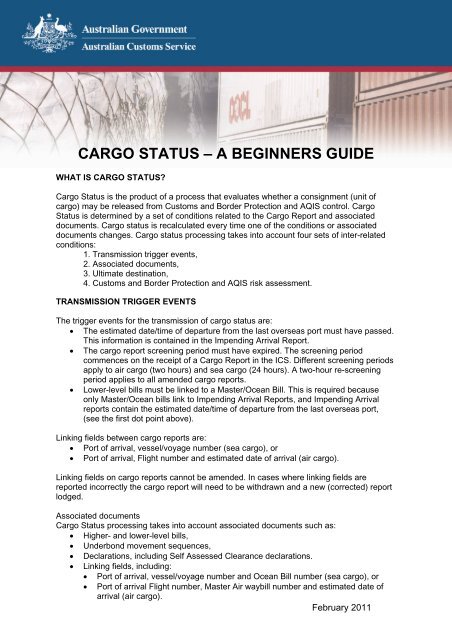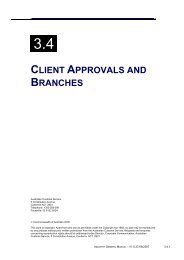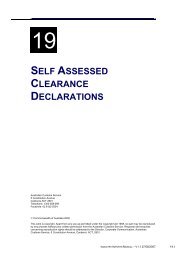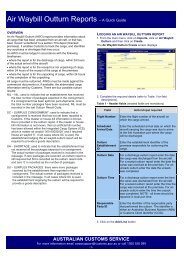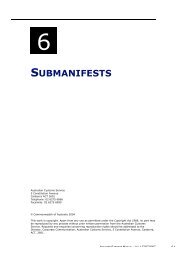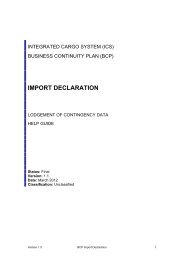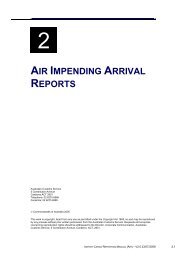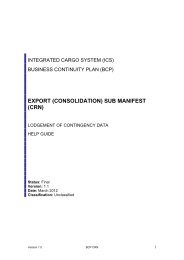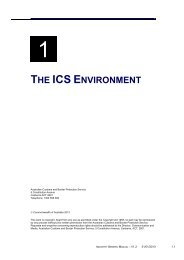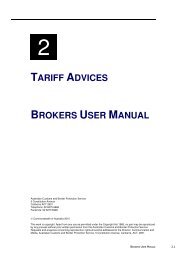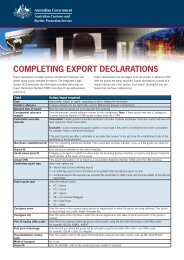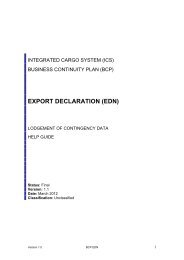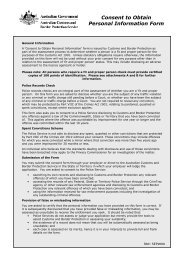Cargo Status - Cargo Support
Cargo Status - Cargo Support
Cargo Status - Cargo Support
Create successful ePaper yourself
Turn your PDF publications into a flip-book with our unique Google optimized e-Paper software.
CARGO STATUS – A BEGINNERS GUIDE<br />
WHAT IS CARGO STATUS?<br />
<strong>Cargo</strong> <strong>Status</strong> is the product of a process that evaluates whether a consignment (unit of<br />
cargo) may be released from Customs and Border Protection and AQIS control. <strong>Cargo</strong><br />
<strong>Status</strong> is determined by a set of conditions related to the <strong>Cargo</strong> Report and associated<br />
documents. <strong>Cargo</strong> status is recalculated every time one of the conditions or associated<br />
documents changes. <strong>Cargo</strong> status processing takes into account four sets of inter-related<br />
conditions:<br />
1. Transmission trigger events,<br />
2. Associated documents,<br />
3. Ultimate destination,<br />
4. Customs and Border Protection and AQIS risk assessment.<br />
TRANSMISSION TRIGGER EVENTS<br />
The trigger events for the transmission of cargo status are:<br />
• The estimated date/time of departure from the last overseas port must have passed.<br />
This information is contained in the Impending Arrival Report.<br />
• The cargo report screening period must have expired. The screening period<br />
commences on the receipt of a <strong>Cargo</strong> Report in the ICS. Different screening periods<br />
apply to air cargo (two hours) and sea cargo (24 hours). A two-hour re-screening<br />
period applies to all amended cargo reports.<br />
• Lower-level bills must be linked to a Master/Ocean Bill. This is required because<br />
only Master/Ocean bills link to Impending Arrival Reports, and Impending Arrival<br />
reports contain the estimated date/time of departure from the last overseas port,<br />
(see the first dot point above).<br />
Linking fields between cargo reports are:<br />
• Port of arrival, vessel/voyage number (sea cargo), or<br />
• Port of arrival, Flight number and estimated date of arrival (air cargo).<br />
Linking fields on cargo reports cannot be amended. In cases where linking fields are<br />
reported incorrectly the cargo report will need to be withdrawn and a new (corrected) report<br />
lodged.<br />
Associated documents<br />
<strong>Cargo</strong> <strong>Status</strong> processing takes into account associated documents such as:<br />
• Higher- and lower-level bills,<br />
• Underbond movement sequences,<br />
• Declarations, including Self Assessed Clearance declarations.<br />
• Linking fields, including:<br />
• Port of arrival, vessel/voyage number and Ocean Bill number (sea cargo), or<br />
• Port of arrival Flight number, Master Air waybill number and estimated date of<br />
arrival (air cargo).<br />
February 2011
Documents that do not affect <strong>Cargo</strong> <strong>Status</strong> are:<br />
• Actual Arrival Reports<br />
• Outturn Reports, including Progressive Discharge Reports<br />
• Import Declaration where mode of arrival is ‘Post’ or ‘Other’.<br />
ULTIMATE DESTINATION<br />
<strong>Cargo</strong> status takes into account the ultimate destination of cargo.<br />
For cargo destined to a non-Australian port the ICS assigns a status of transit or<br />
transhipment as appropriate. For cargo destined to an Australian port, status takes into<br />
account whether the release premises are located in the destination port.<br />
CUSTOMS AND BORDER PROTECTION AND AQIS RISK ASSESSMENT<br />
Customs and Border Protection or AQIS risk assessment may create an impediment to the<br />
release of cargo that will be reflected in the cargo status.<br />
<strong>Cargo</strong> <strong>Status</strong> Advice (CSA) message<br />
The cargo status process will derive the values of the relevant status conditions and use the<br />
combination of the values to determine <strong>Cargo</strong> <strong>Status</strong>. The process will also determine<br />
whether a <strong>Cargo</strong> <strong>Status</strong> Advice (CSA) message needs to be transmitted. Where a CSA<br />
message is required, the message will be compiled and passed to Outbound Messaging for<br />
transmission to the appropriate parties.<br />
X-Ray Examination Advice (XRAYADV) message<br />
In cases where cargo is selected for x-ray examination, an X-Ray Examination Advice<br />
(XRAYADV) message is sent to the relevant stevedore/CTO. In these cases the status<br />
condition CARGO REPORT EVALUATED and corresponding EVALUATION COMPLETE<br />
conditions will be NO. The underbond movement condition is likely to display as NO<br />
MOVEMENT ALLOWED.<br />
Note: This combination of conditions is not unique to XRAY holds.<br />
<strong>Cargo</strong> <strong>Status</strong> display screens<br />
<strong>Cargo</strong> status is displayed on the Import Document <strong>Status</strong> Summary View screen or the<br />
Import Document <strong>Status</strong> Detail View screen. These screens are navigated to using the<br />
status hyperlinks on the import declaration or the cargo report.<br />
<strong>Cargo</strong> status is also displayed in summary on the Transport Details view screen of a Full<br />
Import Declaration. Selecting the “Show Hyperlinks” options button causes a hyperlink to<br />
the Import Document <strong>Status</strong> Summary View screen to display.<br />
For Sea <strong>Cargo</strong> consolidated status is displayed on the Vessel Summary List and the Sea<br />
<strong>Cargo</strong> Report List/View screens.<br />
For Air <strong>Cargo</strong> consolidated status is only displayed to the party reporting the <strong>Cargo</strong> Report<br />
or the associated declaration. These parties may view consolidated status on the Air <strong>Cargo</strong><br />
Report List or View screens or via the Transport Details view screen respectively.<br />
2<br />
Revised February 2011
Examples of screen displays<br />
This is an example of the Import Document <strong>Status</strong> Summary screen.<br />
This is an example of the Import Document <strong>Status</strong> Detail screen.<br />
3<br />
Revised February 2011
This is an example of a Vessel Summary List screen.<br />
This is an example of an Air <strong>Cargo</strong> Report List screen.<br />
4<br />
Revised February 2011
Import Document <strong>Status</strong> Summary View<br />
The Import Document <strong>Status</strong> Summary View screen displays a summary of status<br />
information for an import document.<br />
The following section describes each of the sections of this screen.<br />
Section/<strong>Status</strong> Meaning Action required<br />
Transhipment Number<br />
This field will be blank (indicating<br />
that the cargo is not being<br />
transhipped) if:<br />
• the cargo report shows a<br />
port of discharge in<br />
Australia and a port of<br />
destination in Australia,<br />
OR<br />
• an UBMR with the<br />
movement reason TSH<br />
has not been approved<br />
for the cargo.<br />
IF the cargo is being<br />
transhipped and the<br />
departure (export)<br />
establishment is the same as<br />
the arrival (import)<br />
establishment then:<br />
Check that the port of<br />
destination on the cargo<br />
report is not in Australia.<br />
IF the cargo is being<br />
transhipped and the<br />
departure (export)<br />
establishment is not the<br />
same as the arrival (import)<br />
establishment then:<br />
Check that a UBMR with<br />
movement reason TSH has<br />
been lodged and approved.<br />
Consolidated <strong>Status</strong><br />
Consolidated status does not mean that the status is for consolidated cargo. Consolidated<br />
status is the overall status of the cargo incorporating Customs and Border Protection and<br />
AQIS on both the cargo report and the declaration. Consolidated status will be one of the<br />
following:<br />
CLEAR<br />
The consignment is clear of all<br />
impediments (the four interrelated<br />
conditions are all met)<br />
and the cargo may be released<br />
into home consumption.<br />
Nil<br />
CONDCLEAR<br />
HELD<br />
The consignment may be<br />
delivered into Home<br />
Consumption after certain<br />
conditions have been met. For<br />
example AQIS approved<br />
fumigation, or a s.71E movement<br />
application has been approved.<br />
After the expiry of the screening<br />
period, a HELD status indicates<br />
that there is an impediment to the<br />
release of cargo into home<br />
consumption. For example, the<br />
impending arrival report has not<br />
been lodged, a voyage number<br />
has been incorrectly reported, a<br />
Master or Ocean Bill has not<br />
been reported or an AQIS or<br />
Customs and Border Protection<br />
View Conditions and<br />
Impediment details displayed<br />
on the lower section of the<br />
Import Document <strong>Status</strong><br />
Summary screen.<br />
Identify which element of<br />
status is causing the HELD<br />
status.<br />
Navigate to the Import<br />
Document <strong>Status</strong> Detail<br />
screen.<br />
Consult the Import<br />
Document <strong>Status</strong> Detail<br />
section at page 3.<br />
5<br />
Revised February 2011
SUBUBMOV<br />
DCLALLOWED<br />
TRANSHIP<br />
TRANSIT<br />
WITHDRAWN<br />
ACSSEIZED<br />
examination is required. It must<br />
not be assumed that a Customs<br />
and Border Protection or AQIS<br />
impediment is causing the HELD<br />
status.<br />
Consolidated cargo must, subject<br />
to an approved underbond<br />
movement request, be moved to<br />
approved premises and<br />
deconsolidated before it can be<br />
released into home consumption.<br />
Consolidated cargo is sea cargo<br />
described as LCL and air cargo<br />
on a HAWB. Higher-level bills will<br />
receive this status.<br />
Consolidated air cargo may be<br />
deconsolidated at sub-master<br />
airway bill level (without the<br />
requirement for further<br />
underbond movement) where the<br />
lower-level airway bills have the<br />
same responsible party as the<br />
sub-master airway bill.<br />
The cargo may be transhipped<br />
through Australia. Transhipment<br />
cargo has an Australian port of<br />
discharge and an overseas port<br />
of destination. If the departure<br />
(export) establishment is not the<br />
same as the arrival (import)<br />
establishment then an approved<br />
Underbond Movement Request<br />
is also required.<br />
The cargo may transit through<br />
Australia. Transit cargo has an<br />
overseas port of discharge and<br />
an overseas port of destination.<br />
Transit cargo may be re-stowed<br />
while in an Australian port.<br />
The cargo report has been<br />
withdrawn. A withdrawn cargo<br />
report may not be further<br />
amended. A withdrawn cargo<br />
report will be displayed with the<br />
word WITHDRAWN in red text<br />
across the top centre of the<br />
report.<br />
After completing an assessment<br />
an authorised Customs and<br />
Border Protection officer has<br />
Check the <strong>Cargo</strong> Type on<br />
the lowest level bill.<br />
For sea cargo where the<br />
<strong>Cargo</strong> Type on the lowest<br />
level bill is FCL or, FCX, or<br />
bulk, or break bulk – NO<br />
ACTION is required.<br />
For cargo on the lowest level<br />
bill, either HBL or HAWB, an<br />
approved Underbond<br />
Movement Request with the<br />
movement reason DCL<br />
(deconsolidation) is required.<br />
Nil.<br />
Note: This status applies to<br />
air cargo only.<br />
Nil. The TRANSHIPMENT<br />
NUMBER field should also<br />
be populated with a nine<br />
alphanumeric character<br />
identifier. This identifier is a<br />
Customs Authority Number<br />
(CAN) for export and must<br />
be quoted on all applicable<br />
CTO Receival Notices and<br />
Export Manifests.<br />
Nil.<br />
Nil.<br />
Nil.<br />
6<br />
Revised February 2011
CLEARHRM<br />
TRANSHPHRM<br />
AQIS SEIZED<br />
determined the goods to be<br />
seized or detained under relevant<br />
legislation.<br />
Clear High Risk Movement - a<br />
status applied by AQIS to allow<br />
release of certain AQIS risks.<br />
The risk may be related to the<br />
commodity, Australian<br />
destination or the origin of the<br />
goods. These consignments<br />
must be delivered to AQIS<br />
approved premises.<br />
High Risk Movement<br />
Transhipment allowed - a status<br />
applied by AQIS to allow<br />
transhipment of certain AQIS<br />
risks. The risk may be related to<br />
the commodity or the origin of the<br />
goods. These consignments may<br />
only be transhipped through<br />
AQIS approved premises.<br />
After completing an assessment<br />
an authorised AQIS officer has<br />
determined the goods to be<br />
seized or detained under relevant<br />
legislation.<br />
Nil. For further information<br />
on AQIS High Risk<br />
Movements call (02) 6272<br />
5913.<br />
Nil. For further information<br />
on AQIS High Risk<br />
Movements call (02) 6272<br />
5913.<br />
Nil<br />
Underbond Movement Conditions<br />
Underbond Movement Conditions advise of the status of the cargo in respect of underbond<br />
movements. Underbond Movement conditions will be one of the following:<br />
MOVEMENT<br />
ALLOWED<br />
The cargo may be moved in<br />
accordance with the lodged<br />
approved underbond movement<br />
request(s).<br />
Nil.<br />
SINGLE MOVEMENT<br />
ALLOWED<br />
NO MOVEMENT<br />
ALLOWED<br />
The cargo may be moved in<br />
accordance with the first<br />
underbond movement request in<br />
the approved underbond<br />
movement request chain.<br />
The cargo may not be moved<br />
underbond at this time. Any<br />
underbond movement requests<br />
in relation to this cargo have not<br />
been approved at this time.<br />
Nil.<br />
Nil.<br />
<br />
7<br />
If this field is blank then there are<br />
no underbond movement<br />
requests associated with this<br />
cargo at this time.<br />
<strong>Status</strong> conditions (Import Document <strong>Status</strong> Summary Screen)<br />
<strong>Cargo</strong> Report<br />
Evaluated<br />
This will be NO if any of the<br />
<strong>Cargo</strong> Report status conditions<br />
Nil.<br />
The word NO is a hyperlink<br />
for navigation to Import<br />
Document <strong>Status</strong> Detail view<br />
Revised February 2011
Import Declaration<br />
Evaluated<br />
Import Declaration<br />
Evaluated (cont)<br />
are NO.<br />
This will be NO if any of the<br />
Import Declaration status<br />
conditions are set to NO.<br />
This will be N/A when:<br />
• the cargo is NOT being<br />
cleared on a FID or SAC<br />
declaration; OR<br />
• an Import Declaration has<br />
not yet been lodged for<br />
the cargo; OR<br />
• an Import Declaration that<br />
has been lodged for the<br />
cargo has failed to link to<br />
the <strong>Cargo</strong> Report.<br />
screen. Identify the status<br />
element that is causing the<br />
impediment and see the<br />
relevant item in the ‘Import<br />
Document <strong>Status</strong> Detail’<br />
section at page 3.<br />
The word NO is a hyperlink<br />
for navigation to Import<br />
Document <strong>Status</strong> Detail view<br />
screen. Identify the status<br />
element that is causing the<br />
impediment and see the<br />
relevant item in the ‘Import<br />
Document <strong>Status</strong> Detail’<br />
section at page 3.<br />
IF the cargo is not being<br />
cleared on a FID or SAC<br />
declaration – Nil.<br />
IF the cargo is being cleared<br />
on a FID or SAC declaration:<br />
Check that a FID or SAC has<br />
been lodged.<br />
If a FID or SAC has been<br />
lodged:<br />
Check the linking fields on<br />
the FID or SAC match the<br />
<strong>Cargo</strong> Report. Correct any<br />
errors.<br />
Note: <strong>Cargo</strong> cannot be cleared on a <strong>Cargo</strong> Report SAC where a declaration (FID or<br />
separately lodged SAC) has already been lodged. In cases where both a <strong>Cargo</strong> Report<br />
SAC and a declaration are lodged for the same cargo then that cargo will not be released<br />
until either:<br />
• the declaration (FID or separately lodged SAC) is withdrawn; OR<br />
• the <strong>Cargo</strong> Report is amended with the <strong>Cargo</strong> Report SAC checkbox un-checked.<br />
Import Declaration<br />
Paid<br />
This will be NO if any of the<br />
import declarations relating to the<br />
cargo report line are yet to be<br />
paid.<br />
This will be N/A when:<br />
• the cargo is NOT being<br />
cleared on a FID or SAC<br />
declaration; OR<br />
• an Import Declaration has<br />
not yet been lodged for<br />
the cargo; OR<br />
• an Import Declaration that<br />
has been lodged for the<br />
The broker/owner must pay<br />
the declaration.<br />
Note: FCX or LCL cargo may<br />
have more than one<br />
declaration relating to a<br />
cargo report line. In this case<br />
every declaration must be<br />
paid.<br />
IF the cargo is not being<br />
cleared on a FID or SAC<br />
declaration – no action is<br />
required.<br />
IF the cargo is being cleared<br />
on a FID or SAC declaration:<br />
Check that a FID or SAC has<br />
been lodged.<br />
If a FID or SAC has been<br />
8<br />
Revised February 2011
<strong>Cargo</strong> Report SAC<br />
Supplementary<br />
Information:<br />
(Conditional Hold<br />
Exists)<br />
cargo has failed to link to<br />
the <strong>Cargo</strong> Report.<br />
This will be NO if the cargo<br />
reporter has not cleared the<br />
cargo on this cargo report by<br />
selecting the <strong>Cargo</strong> Report SAC<br />
checkbox.<br />
Where a Conditional Hold<br />
occurs, additional information will<br />
display in the lower section of the<br />
screen.<br />
Supplementary information<br />
covers both conditional release<br />
notes and impediment details.<br />
Conditional release notes contain<br />
a combination of preformatted<br />
and officer added text to describe<br />
the conditions of the release.<br />
lodged:<br />
Check the linking fields on<br />
the FID or SAC match the<br />
<strong>Cargo</strong> Report. Correct any<br />
errors.<br />
Nil.<br />
Note: In cases where cargo<br />
is cleared on a <strong>Cargo</strong> Report<br />
SAC no declaration (FID or<br />
separately lodged SAC) is<br />
required. In these cases<br />
cargo may be released<br />
(subject to other conditions<br />
being met) even though the<br />
Declaration Evaluated<br />
condition will be N/A.<br />
Note: Supplementary<br />
Information may also display<br />
on the Import Document<br />
<strong>Status</strong> Summary view<br />
screen.<br />
<strong>Cargo</strong> Report<br />
Hierarchy Complete<br />
(Note: this condition<br />
does NOT display)<br />
9<br />
An automatic deficient consignee<br />
message will be displayed in this<br />
section in cases where:<br />
• the consignee name<br />
and/or address on the<br />
cargo report is deficient;<br />
and<br />
• no Import Declaration has<br />
been linked to the <strong>Cargo</strong><br />
Report.<br />
A deficient consignee message<br />
may also be displayed in this<br />
section as the result of Customs<br />
and Border Protection or AQIS<br />
risk assessment.<br />
This condition looks at the linking<br />
of the Master/Ocean Bill to all<br />
House bills reported between the<br />
Master/Ocean Bill and the lowest<br />
House bill. In cases where the<br />
lowest level bill <strong>Cargo</strong> Report<br />
may quote a Parent Bill of Lading<br />
but does not, then the ICS will<br />
consider the lowest level bill to<br />
be the first bill below the Ocean<br />
Bill. Therefore, if the Ocean Bill is<br />
Note: This is not a condition<br />
that affects the consolidated<br />
status derived when status<br />
calculation is processed. It<br />
will only be used to indicate<br />
if supplementary information<br />
is required to be transmitted.<br />
This status condition relies<br />
heavily on the accuracy of<br />
the Parent Bill of Lading data<br />
on the <strong>Cargo</strong> Report.<br />
Revised February 2011
already reported then the upward<br />
hierarchy is considered<br />
complete.<br />
Import Document <strong>Status</strong> Detail View<br />
The Import Document <strong>Status</strong> Summary View screen displays a summary of status<br />
information for an import document.<br />
The following section describes each of the sections of this screen.<br />
Section/<strong>Status</strong> Meaning Action required<br />
<strong>Status</strong> conditions (Import Document <strong>Status</strong> Detail Screen)<br />
<strong>Cargo</strong> Report<br />
Evaluated<br />
This will be NO if one or more of<br />
the status conditions described<br />
below are NO. In this case all the<br />
cargo report conditions will<br />
display<br />
This will be YES if all of the<br />
status conditions described<br />
below are YES. In this case none<br />
of the cargo report conditions will<br />
display.<br />
Identify the condition(s)<br />
causing the NO condition<br />
and correct as required.<br />
Nil.<br />
Evaluation Complete<br />
Impending Arrival<br />
Report Received<br />
This will be NO if the Customs<br />
and Border Protection/AQIS risk<br />
assessment evaluation process<br />
is not yet complete.<br />
This will be NO if:<br />
• an Impending Arrival<br />
Report is not linked to the<br />
<strong>Cargo</strong> Report, OR<br />
• the Master/Ocean Bill<br />
hasn’t been reported for<br />
the House bill on this<br />
cargo report.<br />
Check the Supplementary<br />
Information section of the<br />
Import Document <strong>Status</strong><br />
Summary View screen.<br />
Deliver documents to<br />
Customs and Border<br />
Protection or AQIS if<br />
required, and/or carry out<br />
other actions as directed. Do<br />
not send documents to<br />
Customs and Border<br />
Protection/AQIS until notified<br />
you are required to do so.<br />
Check the linking fields on<br />
the Impending Arrival Report<br />
match the <strong>Cargo</strong> Report.<br />
Correct any errors.<br />
Note: To link an IAR and air<br />
CR the same estimated<br />
date/time of arrival and flight<br />
details and port of arrival<br />
details are required. To link<br />
an IAR and sea CR the<br />
same vessel, voyage<br />
number and discharge<br />
port/port of arrival are<br />
required. Consult with the<br />
party responsible for<br />
reporting the Master/Ocean<br />
Bill.<br />
Note: Impending Arrival<br />
Reports only link to <strong>Cargo</strong><br />
Reports at the Master and<br />
Ocean Bill level.<br />
Departure From Last This will be NO if: Check that linking fields are<br />
10<br />
Revised February 2011
Overseas Port • there is no IAR linked to<br />
the <strong>Cargo</strong> Report,<br />
Screening Period<br />
Expired<br />
Quoted Ocean/Master<br />
Bill Exists<br />
11<br />
OR<br />
• The Estimated Time of<br />
Departure in the linked<br />
Impending Arrival Report<br />
has not yet passed,<br />
OR<br />
• the current bill is a lowerlevel<br />
bill and<br />
• the associated<br />
Master/Ocean Bill has not<br />
yet been reported; OR<br />
• the current bill is a lowerlevel<br />
bill; and<br />
• the associated<br />
Master/Ocean Bill that<br />
has been lodged has<br />
failed to link to the lowerlevel<br />
bill <strong>Cargo</strong> Report.<br />
This will be NO if the screening<br />
period has not expired.<br />
Screening periods commence<br />
when the cargo report is lodged.<br />
Screening periods are:<br />
• air cargo - 2 hours;<br />
• sea cargo - 24 hours;<br />
• all amendments - 2 hour<br />
re-screening period that<br />
commences on the<br />
lodgement of new<br />
amended report.<br />
This will be NO if a House bill<br />
quotes a Ocean/Master bill that<br />
has either:<br />
• not been reported; or<br />
• been withdrawn.<br />
the same on the <strong>Cargo</strong><br />
Report and the Impending<br />
Arrival Report. Correct as<br />
required.<br />
Note: To link an IAR and air<br />
CR the same estimated<br />
date/time of arrival and flight<br />
details and port of arrival<br />
details are required. To link<br />
an IAR and sea CR the<br />
same vessel, voyage<br />
number and discharge<br />
port/port of arrival are<br />
required. Consult the<br />
relevant responsible party for<br />
the Impending Arrival<br />
Report. Check that the<br />
Master/Ocean Bill has been<br />
lodged. Consult with the<br />
relevant responsible party.<br />
Check the linking fields for<br />
Master/Ocean Bill <strong>Cargo</strong><br />
Report. Consult with the<br />
relevant responsible party.<br />
Correct any errors.<br />
Note: Impending Arrival<br />
Reports only link to <strong>Cargo</strong><br />
Reports at the Master and<br />
Ocean Bill level. House bills<br />
can only link to the<br />
Impending Arrival Report<br />
through the Master/Ocean<br />
Bill.<br />
Check the lodgement time of<br />
the <strong>Cargo</strong> Report, or<br />
Consult the relevant<br />
responsible party for the<br />
<strong>Cargo</strong> Report.<br />
For sea cargo check the<br />
Ocean Bill has been<br />
reported by using a Vessel<br />
Summary search.<br />
For air cargo consult the<br />
relevant reporting party. For<br />
air cargo consolidated status<br />
is only displayed to the party<br />
reporting the <strong>Cargo</strong> Report.<br />
If the Ocean/Master bill has<br />
not been reported or has<br />
been withdrawn then consult<br />
Revised February 2011
Impending Arrival<br />
Report Cleared<br />
Complete Underbond<br />
Series Approved<br />
This will be NO if Customs and<br />
Border Protection or AQIS<br />
assess that the nature and<br />
degree of risk for a vessel or<br />
aircraft requires the holding of all<br />
cargo on a vessel or aircraft. For<br />
example the risk of Giant African<br />
Snail (GAS) infestation.<br />
This indicator will be NO if any<br />
one of the following conditions<br />
apply:<br />
• The UBMR, or UBMR<br />
series for the cargo, does<br />
not form a continuous<br />
chain for the movement of<br />
the cargo from the place<br />
of discharge to the place<br />
of release, OR<br />
• The UBMR, or UBMR<br />
series for the container, is<br />
NOT approved, OR<br />
• There are one or more<br />
unapproved UBMR(s)<br />
separate from the<br />
approved chain for the<br />
<strong>Cargo</strong> Report Line being<br />
released.<br />
relevant reporting party.<br />
If the Ocean/Master has<br />
been reported and has not<br />
been withdrawn then check<br />
the relevant linking field<br />
information.<br />
Check the Supplementary<br />
Information section of the<br />
Import Document <strong>Status</strong><br />
Summary View screen.<br />
Deliver documents to<br />
Customs and Border<br />
Protection or AQIS if<br />
required, and/or carry out<br />
other actions as directed. Do<br />
not send documents to<br />
Customs and Border<br />
Protection/AQIS until notified<br />
you are required to do so.<br />
Check that the UBMR to<br />
move the cargo from the<br />
place of discharge shows the<br />
correct Discharge<br />
Establishment ID.<br />
Check that the UBMR chain<br />
is complete from discharge<br />
establishment to place of<br />
release. Check the<br />
Underbond Movement<br />
Conditions on the Import<br />
Document <strong>Status</strong> Summary<br />
screen. Consult with relevant<br />
reporting parties and either:<br />
• complete the UBMR<br />
chain to move the<br />
cargo; OR<br />
• withdraw the UBMR<br />
that is separate from<br />
the approved chain.<br />
Lowest Level Bill<br />
12<br />
This will be NO where the current<br />
cargo report is quoted as the<br />
higher bill for another cargo<br />
report and that lower-level bill<br />
has also been reported.<br />
The following relationship<br />
between status conditions should<br />
be noted:<br />
If Lowest Level Bill = Yes<br />
and, <strong>Cargo</strong> Is Not Consolidation<br />
= No<br />
then the Freight Forwarder check<br />
box has been checked and either<br />
• a lower bill has not yet<br />
been lodged, OR<br />
In cases where this cargo<br />
report is not the lowest level<br />
bill NO ACTION is required.<br />
Note: <strong>Cargo</strong> will NOT be<br />
released against this bill.<br />
<strong>Cargo</strong> will only be released<br />
against the lowest level bill.<br />
In cases where this cargo<br />
report is for the lowest level<br />
bill then amend the cargo<br />
report by un-checking the<br />
Freight Forwarder indicator.<br />
• a lower bill that has been<br />
lodged has not linked to<br />
Revised February 2011
Deconsolidation<br />
Underbond Satisfied<br />
the higher-level bill.<br />
This will be set to NO if:<br />
• the cargo is part of a<br />
consolidation and<br />
• a UBMR with the<br />
movement reason DCL<br />
(deconsolidation) has not<br />
been lodged for this<br />
cargo.<br />
Check the movement<br />
reasons on the UBMR<br />
associated with this cargo.<br />
At least one movement<br />
reason must be DCL<br />
(deconsolidation). Consult<br />
with reporting parties and<br />
amend UBMR as required.<br />
Note: For ICS purposes all<br />
cargo on a House bill is part<br />
of a consolidation, and must<br />
be deconsolidated before it<br />
can be released.<br />
<strong>Cargo</strong> Not a<br />
Consolidation<br />
Release Premise in<br />
Destination Port<br />
13<br />
This will be NO if:<br />
• the Freight Forward<br />
Indicator on the cargo<br />
report has been selected;<br />
OR<br />
• the Freight Forward<br />
Indicator has been set to<br />
YES by the ICS. The ICS<br />
would set this when a<br />
lower bill quoting this bill<br />
as a higher-level bill was<br />
lodged.<br />
The following relationship<br />
between status conditions should<br />
be noted:<br />
If <strong>Cargo</strong> Is Not Consolidation =<br />
No<br />
and Lowest Level Bill = Yes,<br />
then the Freight Forward<br />
Indicator check box has been<br />
checked and either<br />
• a lower bill has not yet<br />
been lodged; OR<br />
• a lower bill that has been<br />
lodged has not linked to<br />
the higher-level bill.<br />
This applies only to the lowest<br />
level cargo reports, (Lowest<br />
Level Bill = ‘YES’). This will be<br />
NO if either:<br />
• Discharge & Destination<br />
Ports on the <strong>Cargo</strong><br />
Report are different; and<br />
• there is no approved<br />
Underbond Movement<br />
Request for the cargo;<br />
OR<br />
• The destination premises<br />
on the last UBMR in the<br />
series for the cargo is<br />
In cases where this cargo<br />
report is for the lowest level<br />
bill then amend the cargo<br />
report by un-checking the<br />
Freight Forward Indicator.<br />
In cases where this cargo<br />
report is not for the lowest<br />
level bill and a lower-level bill<br />
has not been lodged, consult<br />
with responsible parties.<br />
In cases where this cargo<br />
report is not for the lowest<br />
level bill and a lower-level bill<br />
has been lodged but has<br />
failed to link, consult with<br />
responsible parties and<br />
correct as required<br />
Note: <strong>Cargo</strong> will NOT be<br />
released against<br />
consolidation bills. <strong>Cargo</strong> will<br />
only be released against the<br />
lowest level bill.<br />
Consult with relevant<br />
reporting parties.<br />
If the cargo is being released<br />
from premises located in the<br />
port of destination shown on<br />
the cargo report that are not<br />
in the discharge port then a<br />
UBMR, or a UBMR chain, is<br />
required to move the cargo<br />
to the release premises.<br />
If the cargo is being released<br />
from premises not located in<br />
the port of destination shown<br />
on the cargo report amend<br />
the port of destination on the<br />
Revised February 2011
Import Declaration<br />
Evaluated<br />
Evaluation Complete<br />
NOT located at the<br />
Destination Port quoted<br />
on the <strong>Cargo</strong> Report.<br />
This will be NO if one or more of<br />
the status conditions described<br />
below are NO. In this case all the<br />
declaration conditions will<br />
display.<br />
This will be N/A (not available) if<br />
there is no import declaration<br />
(FID or separately lodged SAC)<br />
linked to the cargo report. In this<br />
case none of the declaration<br />
conditions will display.<br />
This will be YES if all of the<br />
status conditions described<br />
below are YES. In this case none<br />
of the declaration conditions will<br />
display.<br />
This will be NO if the Customs<br />
and Border Protection/AQIS risk<br />
assessment evaluation process<br />
is not yet complete.<br />
<strong>Cargo</strong> Report to the port<br />
where the release will occur.<br />
Note: Where the<br />
Master/Ocean bill was the<br />
first bill reported then the<br />
Discharge Port is the port<br />
quoted on the Master/Ocean<br />
bill. Where the House bill is<br />
the first bill reported then the<br />
Discharge Port is the port<br />
quoted on the House bill.<br />
Identify the condition(s)<br />
causing the NO condition<br />
and correct as required.<br />
Nil.<br />
Nil.<br />
No action is required. Do not<br />
send documents to Customs<br />
and Border Protection/AQIS<br />
until you are notified you are<br />
required to do so.<br />
Import Declaration<br />
Match<br />
14<br />
This will be NO unless one and<br />
only one of the following<br />
combination of declarations is<br />
submitted for the cargo:<br />
• One or more Full<br />
Declarations (Nature 10,<br />
Nature 20, Nature 10/20);<br />
• One Informal Clearance<br />
• One Informal Clearance<br />
and one Full Declaration<br />
• One Full Declaration and<br />
one or more<br />
Unaccompanied Personal<br />
Effects (UPE) Statements<br />
• One or more UPE<br />
Statements<br />
If possible identify other<br />
parties who have lodged<br />
declarations and arrange<br />
withdrawal of duplicate<br />
declarations.<br />
Otherwise call Customs<br />
Information and <strong>Support</strong><br />
Centre – 1300 558 099<br />
• One Self Assessed<br />
Clearance (SAC)<br />
Declaration (this may be<br />
either short format SAC,<br />
with or without lines, or a<br />
full declaration format<br />
SAC)<br />
This will be N/A (not available) if<br />
Revised February 2011
there is no import declaration<br />
(FID or separately lodged SAC)<br />
linked to the cargo report.<br />
15<br />
Revised February 2011
<strong>Status</strong> of an Import Declaration<br />
In addition to the cargo status applicable to an import document, import declarations also<br />
have a document status. Import declaration document status is displayed on the<br />
Navigation Options View screen. Below is an example of an Import Declaration (N10)<br />
Navigations Options View Screen:<br />
The import declaration document status will be one of the following<br />
<strong>Status</strong> Meaning Notes<br />
CLEAR<br />
HELD<br />
FINALISED<br />
WITHDRAWN<br />
REJECTED<br />
Duty, taxes and charges applicable to<br />
this import declaration may be paid.<br />
There is an un-acquitted Customs and<br />
Border Protection/AQIS Alert/Profile<br />
match and/or evaluation hold where the<br />
match or evaluation causes the cargo to<br />
be held. Duty, taxes and charges<br />
applicable to this import declaration<br />
cannot be paid.<br />
Duty, taxes and charges applicable to<br />
this import declaration have been paid.<br />
The import declaration has been<br />
withdrawn.<br />
A request for refund has been received<br />
and rejected for this import declaration.<br />
Nil.<br />
Duty, taxes and charges<br />
applicable to a HELD import<br />
declaration may be paid if an<br />
EXAMINATION ADVICE has<br />
been issued by Customs and<br />
Border Protection or AQIS.<br />
Nil.<br />
Nil.<br />
This status only applies to<br />
second or subsequent versions<br />
of an import declaration.<br />
16<br />
Revised February 2011
Interrelationships between Import declaration and <strong>Cargo</strong> status<br />
The following inter-relationships between import declaration status and cargo status should<br />
be noted.<br />
Declaration<br />
status<br />
<strong>Cargo</strong><br />
Report<br />
<strong>Status</strong><br />
Consolidated<br />
<strong>Status</strong><br />
Notes<br />
FINALISED CLEAR CLEAR The cargo may be delivered.<br />
CLEAR CLEAR HELD<br />
FINALISED HELD HELD<br />
CLEAR HELD HELD<br />
HELD CLEAR HELD<br />
HELD HELD HELD<br />
WITHDRAWN HELD<br />
Duty, taxes and charges applicable to this<br />
import declaration may be paid.<br />
Duty, taxes and charges applicable to this<br />
import declaration have been paid. There is<br />
an un-acquitted Customs and Border<br />
Protection/AQIS Alert/Profile match and/or<br />
evaluation hold where the match or evaluation<br />
causes the cargo to be held at <strong>Cargo</strong> Report<br />
level.<br />
Duty, taxes and charges applicable to this<br />
import declaration may be paid. There is an<br />
un-acquitted Customs and Border<br />
Protection/AQIS Alert/Profile match and/or<br />
evaluation hold where the match or evaluation<br />
causes the cargo to be held at <strong>Cargo</strong> Report<br />
level.<br />
Duty, taxes and charges applicable to this<br />
import declaration may not be paid. There is<br />
an un-acquitted Customs and Border<br />
Protection/AQIS Alert/Profile match and/or<br />
evaluation hold where the match or evaluation<br />
causes the cargo to be held at import<br />
Declaration level.<br />
Duty, taxes and charges applicable to this<br />
import declaration may not be paid. There are<br />
un-acquitted Customs and Border<br />
Protection/AQIS Alert/Profile matches and/or<br />
evaluation holds where the match or<br />
evaluation causes the cargo to be held at<br />
<strong>Cargo</strong> Report and Import Declaration level.<br />
The Import Declaration has been withdrawn.<br />
The link between <strong>Cargo</strong> Report and this<br />
Import Declaration has been broken.<br />
Interrelationships between <strong>Cargo</strong> <strong>Status</strong> conditions<br />
1. <strong>Cargo</strong> Not a Consolidation and Lowest Level Bill<br />
If ‘<strong>Cargo</strong> Not a Consolidation’ is NO AND the ‘Lowest Level Bill’ is YES, then the Freight<br />
Forward Indicator check box has been checked and either:<br />
• a lower bill has not yet been lodged; OR<br />
• a lower bill that has been lodged has not linked to the higher-level bill.<br />
17<br />
Revised February 2011
Therefore either:<br />
• the lower-level bill must be lodged; OR<br />
• The lower-level bill must be withdrawn and re-lodged so it links to the higher level<br />
bill; OR<br />
• The Freight Forward Indicator box on this cargo report must be unchecked.<br />
2. <strong>Cargo</strong> Report SAC and Declaration Evaluated<br />
IF <strong>Cargo</strong> Report SAC is YES then a declaration (FID or separately lodged SAC) is NOT<br />
required<br />
therefore Declaration Evaluated will be N/A and cargo may be released (subject to other<br />
conditions being met)<br />
3. <strong>Cargo</strong> Report SAC and Declaration Matched<br />
IF <strong>Cargo</strong> Report SAC is YES (displayed on the Summary Screen) and Declaration Matched<br />
is NO (displayed on the Detail Screen) then either the declaration (FID or separately lodged<br />
SAC) must be withdrawn OR the <strong>Cargo</strong> Report SAC indicator box on this cargo report must<br />
be unchecked.<br />
For more information<br />
Go to: www.cargosupport.gov.au<br />
Email: cargosupport@customs.gov.au<br />
Phone: 1300 558 099<br />
18<br />
Revised February 2011


